Joint distribution Bures–Wasserstein distance based multi-source student teacher network for rotating machinery fault diagnosis
IF 7.9
1区 工程技术
Q1 ENGINEERING, MECHANICAL
引用次数: 0
Abstract
Current research in across working conditions transfer fault diagnosis predominantly relies on single source domain adaptation, neglecting the extensive and diverse diagnostic data available from multiple domains in real-world applications. Furthermore, the joint distribution between fault features and classes is often overlooked in existing multi-source studies, resulting in model failures under varying operational conditions. To address these challenges, a novel multi-source domain diagnostic framework is proposed, leveraging optimal transport theory within a student-teacher learning network. Firstly, the joint distribution Bures–Wasserstein distance is formulated based on the second-order statistic cross-covariance operator, which explicitly models the mapping between fault features and fault labels while also constraining the distribution across different domains. Secondly, a student-teacher network is constructed, with the joint distribution Bures–Wasserstein distance successfully embedded to mitigate distributional discrepancies between domains, while a high-confidence pseudo-labeling strategy is devised to minimize the negative transferability of diagnostic knowledge. The effectiveness of the proposed method is validated using the parallel shaft gearbox and the bearing datasets, the results show that the proposed method has high diagnostic accuracy and robustness.
求助全文
约1分钟内获得全文
求助全文
来源期刊

Mechanical Systems and Signal Processing
工程技术-工程:机械
CiteScore
14.80
自引率
13.10%
发文量
1183
审稿时长
5.4 months
期刊介绍:
Journal Name: Mechanical Systems and Signal Processing (MSSP)
Interdisciplinary Focus:
Mechanical, Aerospace, and Civil Engineering
Purpose:Reporting scientific advancements of the highest quality
Arising from new techniques in sensing, instrumentation, signal processing, modelling, and control of dynamic systems
 求助内容:
求助内容: 应助结果提醒方式:
应助结果提醒方式:


